Any hunter who successfully harvests a game animal is then confronted with the need to field dress the animal as well as with the need to remove the hide from the carcass prior butchering it. In addition, those hunters who choose to pursue large game species such as Elk and Moose are also often confronted with the need to quarter the carcass prior to transport.
However, with all of the different manufacturers in the market today combined with the all of the different types of knives available, viewing even a single knife manufacturer’s web site can present a hunter with so many different choices that choosing the best skinning knife for the intended purpose can be a difficult task.
Therefore, it is important to realize that when choosing a good skinning knife, there are four critical factors consisting of blade size, blade design, blade grind, and blade steel that will enable a person to significantly narrow their choices.
Best Skinning Knives Comparison Chart
Buyer’s Guide to Skinning Knives
As mentioned above, the key features of a well designed skinning knife are the size of the knife, the design of the blade, the type of grind the blade has, and the type of steel from which the blade is constructed:
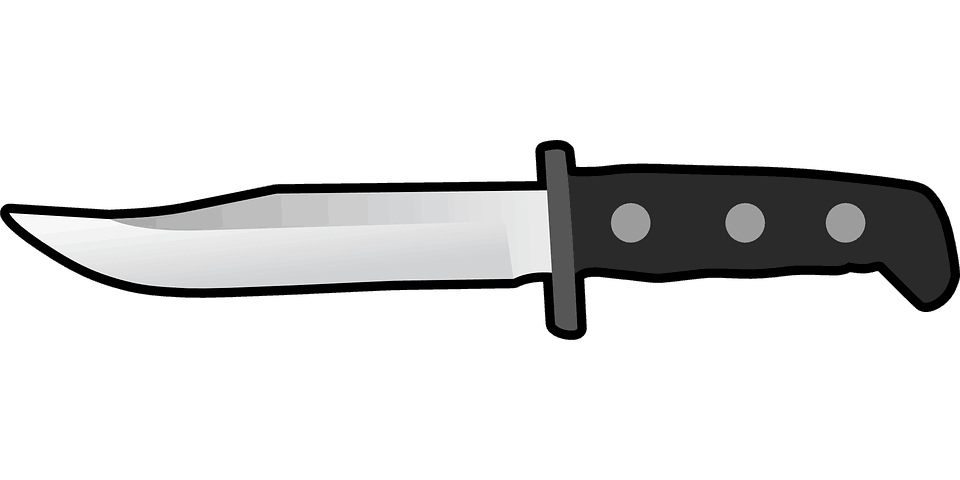 Size – when choosing a skinning knife, you should first be aware of the concept of matching the size of the knife to the size of the game animal.For instance, large knives often work best for skinning large game species such a Elk and Moose while medium sized knives often work best for skinning medium sized game species such as Mule Deer and Whitetail Deer and, small knives often work best for skinning small game species such as Rabbits and Squirrels as well as for caping hides.Therefore, many professional hunting guides prefer knives with blade lengths ranging from 5 to 6 inches when skinning large game, knives with blade lengths ranging from 4 inches to 5 inches for skinning medium sized game animals and, knives with blade lengths ranging from 3 inches to 4 inches for skinning small game animals and for caping.
Size – when choosing a skinning knife, you should first be aware of the concept of matching the size of the knife to the size of the game animal.For instance, large knives often work best for skinning large game species such a Elk and Moose while medium sized knives often work best for skinning medium sized game species such as Mule Deer and Whitetail Deer and, small knives often work best for skinning small game species such as Rabbits and Squirrels as well as for caping hides.Therefore, many professional hunting guides prefer knives with blade lengths ranging from 5 to 6 inches when skinning large game, knives with blade lengths ranging from 4 inches to 5 inches for skinning medium sized game animals and, knives with blade lengths ranging from 3 inches to 4 inches for skinning small game animals and for caping.
- Blade design – when choosing a good skinning knife, blade design is another critical factor that should be carefully considered and there are four different blade designs that tend to work best for this purpose.
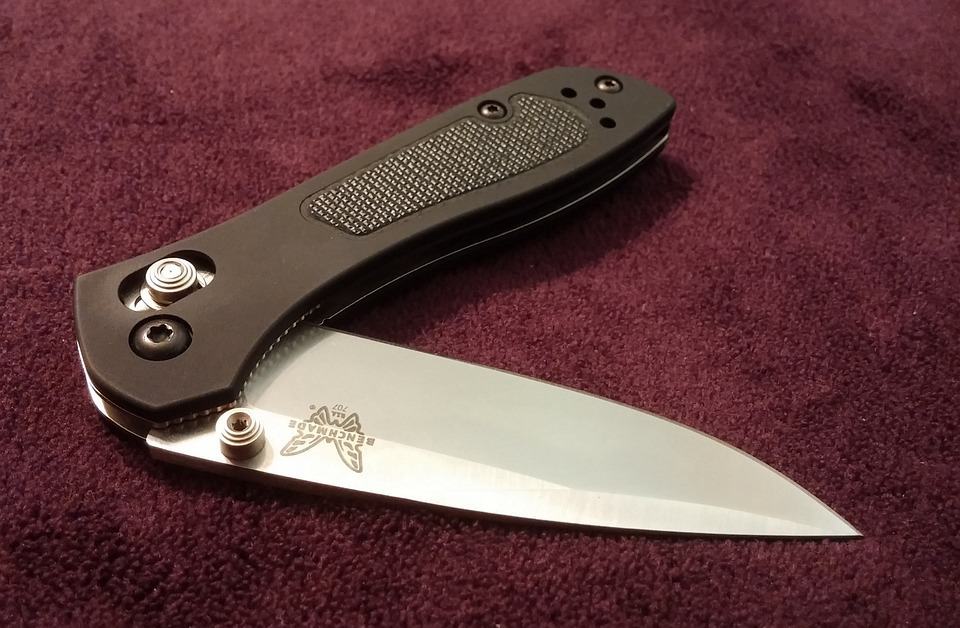 For instance, Drop Points are defined by either a straight or curved back that extends some distance from the handle and then descends to the tip of the blade in a convex curve such that the tip of the blade is positioned below the back of the blade.
For instance, Drop Points are defined by either a straight or curved back that extends some distance from the handle and then descends to the tip of the blade in a convex curve such that the tip of the blade is positioned below the back of the blade.
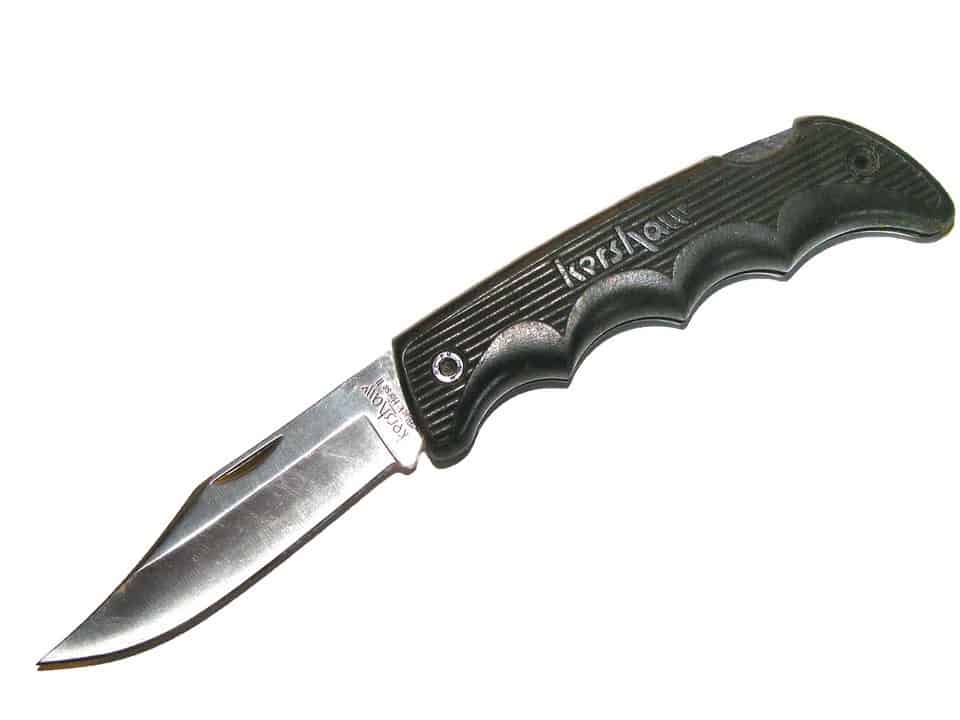
Whereas, Clip Points are defined by a straight back that extends for some distance from the handle and then has either a straight or concave drop to the point which positions the tip below the back of the blade. Tailing Points on the other hand are defined by a back that extends some distance from the handle and then ascends to the tip of the blade in a concave curve such that the tip of the blade is positioned above the back of the blade.

Last, Nessmuks are a hybrid design between Trailing Points and a Drop Points and they are defined by a back that extends some distance from the handle and then ascends above the handle and then descends to the tip of the blade in a convex curve such that the tip of the blade is positioned close to back of the blade. Consequently, both Drop Points and Clip Points provide the user with much greater control over the tip of the blade whereas, both Trailing Points and Nessmuks provide the user with an extended cutting edge.
Therefore, due to the fact that some species of game animals such as Mule Deer and Whitetail Deer have hides that are loosely attached to the muscle tissue by a thin membrane that is easy to stretch and then slice while other species of game animals such as Feral Hogs and Wild Boar have hides that are firmly attached to the muscle tissue via a layer of subcutaneous fat that actually feels somewhat fibrous when you cut it, both Drop Points and Clip Points tend to be the best choice for skinning one type of animal whereas, both Trailing Points and Nessmuks tend to be the best choice for skinning the other type.
 Thus, when removing the hides from animals with loosely attached hides, blades with either a Drop Point or Clip Point design are by far the most popular choice because they place the tip of the knife close to the center line of the blade which provides the user much greater control over the tip of the knife.
Thus, when removing the hides from animals with loosely attached hides, blades with either a Drop Point or Clip Point design are by far the most popular choice because they place the tip of the knife close to the center line of the blade which provides the user much greater control over the tip of the knife.
On the other hand, when removing the hides from animals with tightly attached hides, the hide must literally be carved from the carcass and thus, skinning knives with either a Trailing Point or a Nessmuk blade design work much better because they provide a significantly longer cutting edge than blades with either Drop Points or Clip Points.
- Blade Grind – a third critical factor in choosing a skinning knife is the type of grind the blade has. For instance, in most cases, a Hollow Grind is the best choice because a Hollow Grind creates the thinnest possible cutting edge and thus, it can be honed to razor sharpness.However, knives with Flat Grinds also work well because the Flat Grind creates a slightly thicker cutting edge and, although a Flat Grind cannot be honed as sharp as a Hollow Grind, the edge does not become dull with use quite as fast as a Hollow Grind.But, when quartering large game species, the hunter is required to both separate the vertebrae in the backbone and to pry the hip joints from their sockets in addition to removing the entrails and the hide.Therefore, this task calls for a very strong knife blade made from a tough blade steel and thus, knives with a semi-hollow Double Bevel grind are often a good choice because the spine (the thickest part of the blade) is located in the center of the blade instead of along the back. However, you should avoid knives with Saber Grinds because they purposely create a blade with a very thick cutting edge with is difficult to sharpen and which adds very little lateral strength to the blade.
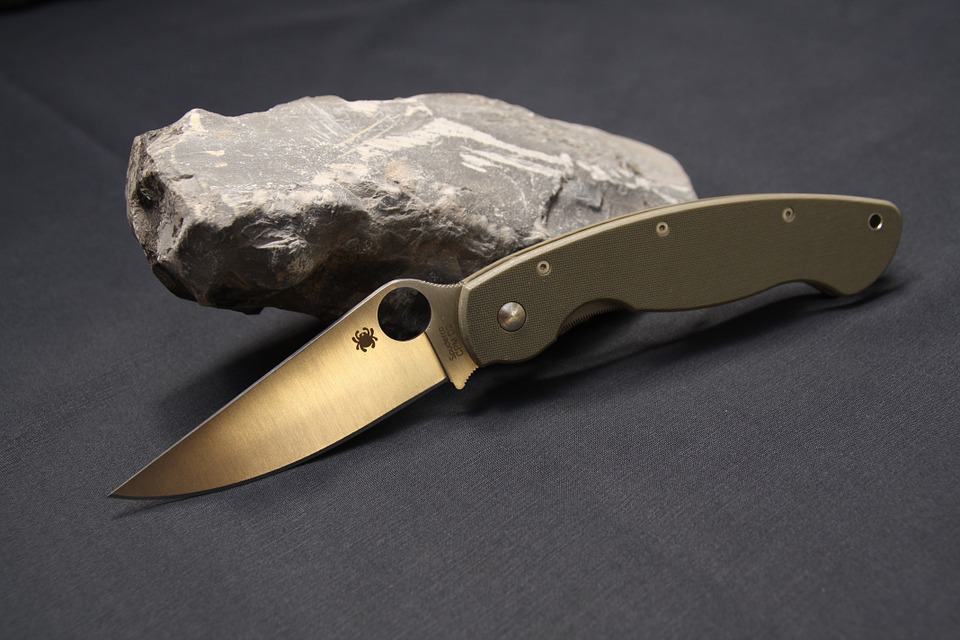
- Blade steel – because it is very annoying to be forced to stop in the middle of removing the hide from a game animal to sharpen your knife, in most cases it is important to choose a skinning knife with a hard blade steel instead of a tough blade steel. Therefore the relative hardness of any given knife blade is measured using the Rockwell C Scale (designated HRC) and thus, most hunting knives range from 54 HRC to 62 HRC.However, it should also be noted that the harder a blade steel is, the more brittle it is and, the more difficult it is to sharpen. Whereas, the softer a blade steel is, the tougher it is and the easier it is to sharpen.Consequently, when choosing a knife for skinning small to medium sized game animals, knives with a Rockwell Hardness of 57 to 60 provide a good compromise between ease of sharpening and the ability to hold an edge.On the other hand, when choosing a knife for skinning and quartering large game species, knives with a Rockwell Hardness of 54 to 56 provide a good compromise between toughness and the ability to hold an edge.
Furthermore, it should be noted that blade steels are clearly divided into two different categories consisting of high carbon tool steels and stainless steels and each has both advantages and disadvantages. For instance, high carbon tool steels such as O1, A2, and CPM 3V tend to be tougher and easier to sharpen than stainless steels but, they also tend to not hold an edge as well.
Whereas, stainless steels such as 440C, CPM-154, ATS34, VG-10, BG-42, and CPM-S30V tend to be less tough and are more difficult to sharpen but, they tend to hold an edge better and are much easier to care for due to their inherent resistance to corrosion. Therefore, most hunters have a distinct preference for stainless steels over high carbon tool steels.
Top 10 Best Skinning Knife Reviews
1. Buck Model 401 Kalinga
** Editor’s Choice – Best Skinning Knife **
The Buck Kalinga is one of Buck’s oldest skinning knife designs and it features an overall length of 10″ with a Trailing Point blade design that measures 4 3/4″ in length. Also, this knife is constructed from 420HC (high carbon) stainless steel hardened to 58 HRC and the blade has a Hollow Grind.
In addition, it also features Full Tang construction with oversized brass bolsters and a finger groove handle design with Rosewood handle scales pinned to the tang with three, non-mosaic, brass, pins and a lanyard loop. Also, because all Buck knives are heat treated by Paul Bos (commonly considered to be a heat treating guru), their use of 420 High Carbon steel rivals the performance of 440C.
However, the trailing point design is somewhat more purpose-specific that either Drop Points or Clip Points and thus, it may not appeal to the large majority of hunters. In addition, considering the somewhat excessive MSRP, it does not represent a particularly good value for the money.
2. Buck Model 110 Folding Hunter
** Best Budget Skinning Knife **
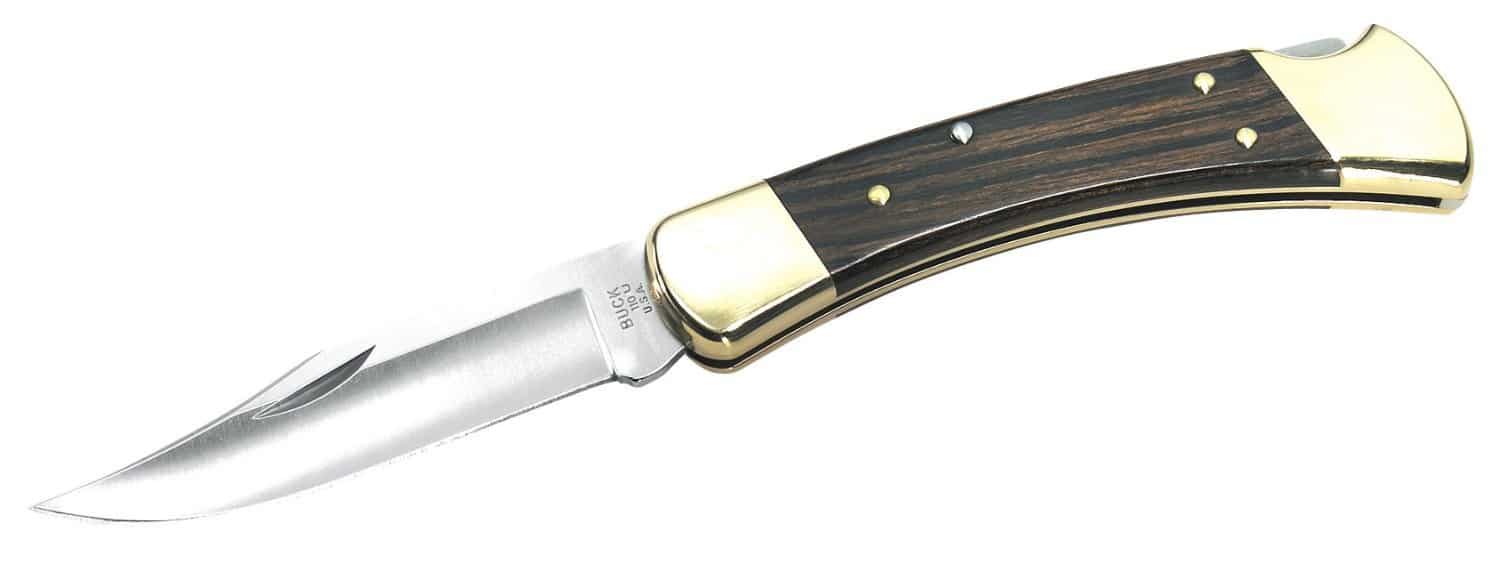
The Buck 110 Folding Hunter is one of the finest production folding skinning knives on the market and it features a closed length of 4 7/8″ with a Clip Point blade design that measures 3 3/4″ in length. Also, the blade of this knife is constructed from 420HC (high carbon) stainless steel hardened to 58 HRC and the blade has a Hollow Grind.
In addition, it also features a large, hand-filling, handle design with a Lockback locking mechanism and high-quality brass bolsters with handle scales made from Macassar Ebony (one of the rarest and most expensive exotic hardwoods available).
Also, because all Buck knives are heat treated by Paul Bos (commonly considered to be a heat treating guru), their use of 420 High Carbon steel rivals the performance of 440C while enabling them to charge less than if they were still using 440C. Therefore, the Buck 110 Folding Hunter is a good value for the money. However, some hunters may not care for the folding lockback design.
3. Browning Storm Front Damascus

The Browning Storm Front Damascus is one of the finest examples of a production skinning knife on the market today and it features an overall length of 8 3/4″ with a Drop Point blade design that measures 4 1/4″ in length. Also, this knife’s blade is made from over 200 layers of hand-forged 1080 and 15N20 high carbon tool steels hardened to 56-58 HRC with a Flat Grind.
Also, it features Hidden Tang construction with a stainless steel bolster and a handle made from Sambar Stag antler. In addition, the high carbon tool steel Damascus blade that is very tough. Yet, with a Rockwell hardness of 56-58 HRC, it will also hold an edge well. However, it should also be noted that high carbon tool steels do require more care to keep them corrosion free than stainless steels do.
Consequently, it is one of the few production hunting knives on the market today with a quality that rivals that of high-end custom knives and thus, the Browning Storm Front Damascus represents an excellent value for the money since a comparable custom knife would commonly cost much more.
4. Boker Arbolito Venador
 The Boker Arbolito Venador is another excellent example of a well-designed skinning knife that features an overall length of 10″ with a Drop Point blade design that measures 5″ in length. Also, this knife is constructed from Bohler N695 stainless steel (an Austrian equivalent to 440C) hardened to 58 HRC with a Hollow Grind.
The Boker Arbolito Venador is another excellent example of a well-designed skinning knife that features an overall length of 10″ with a Drop Point blade design that measures 5″ in length. Also, this knife is constructed from Bohler N695 stainless steel (an Austrian equivalent to 440C) hardened to 58 HRC with a Hollow Grind.
In addition, it also features Full Tang construction with a with handle scales made from Guayacan Ebony (a rare and expensive exotic hardwood) pinned to the tang with two mosaic pins. Thus, not only is this knife both well designed and very comfortable in the hand, it is also very aesthetically pleasing. However, some hunters may not care for the wide Ricasso and the integral finger guard. But, considering the moderate MSRP, it does represent an excellent value for the money.
5. Boker Arbolito Nicker
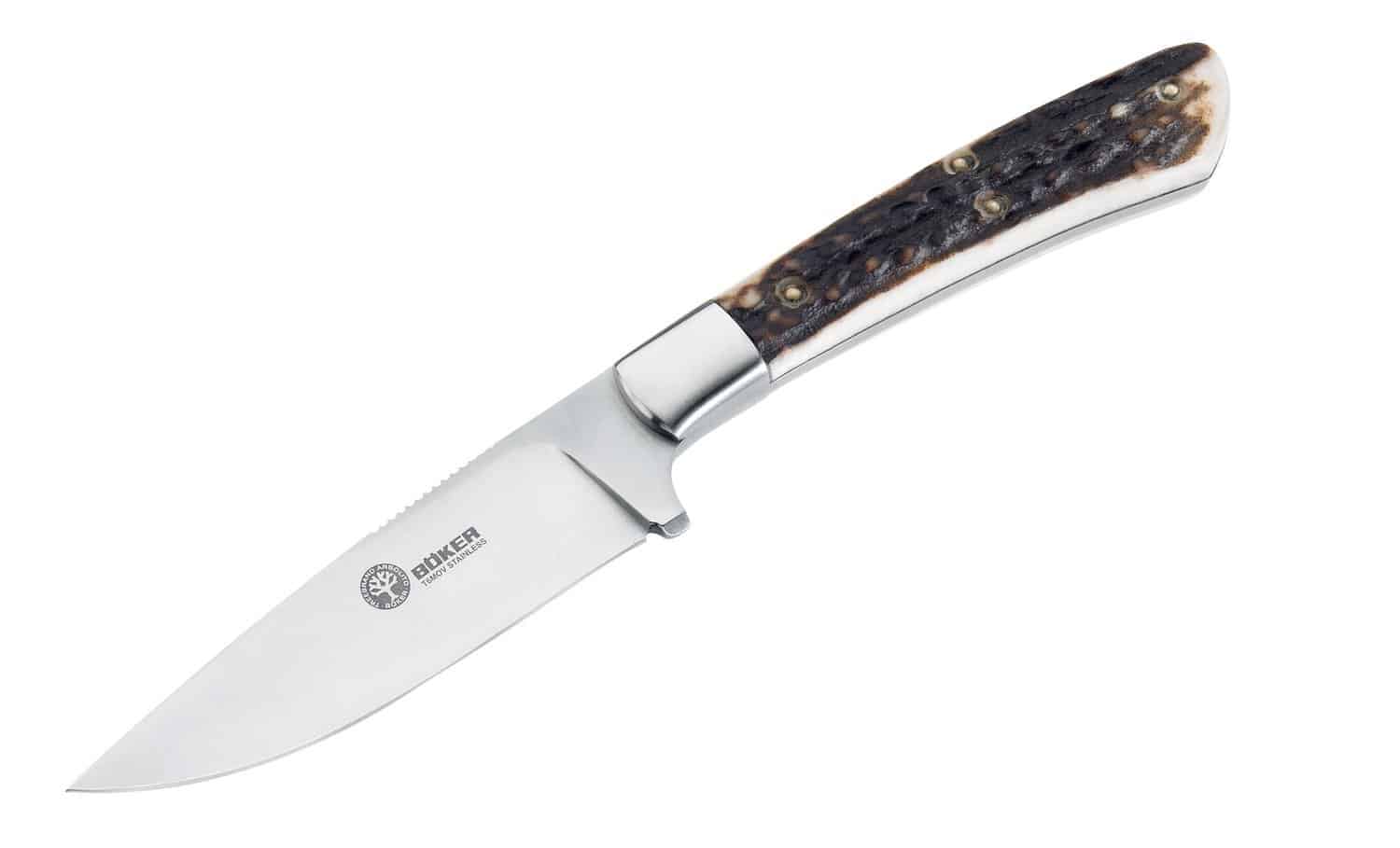 The Boker Arbolito Nicker is a traditional, European-style, skinning knife design that features an overall length of 7 7/8″ inches with a Drop Point blade measuring 3 3/4” in length and is constructed using 440C stainless steel hardened to 58 HRC with a Hollow Grind. In addition, this knife features Full Tang construction with a slim grip and handle scales made from Sambar Stag antler with stainless steel bolsters.
The Boker Arbolito Nicker is a traditional, European-style, skinning knife design that features an overall length of 7 7/8″ inches with a Drop Point blade measuring 3 3/4” in length and is constructed using 440C stainless steel hardened to 58 HRC with a Hollow Grind. In addition, this knife features Full Tang construction with a slim grip and handle scales made from Sambar Stag antler with stainless steel bolsters.
Thus, due to its slim blade and elegant handle design, the Boker Arbolito Nicker is an excellent skinning knife for small game species and for caping hides on larger game species. However, the slim grip may be too small for hunters with large hands. On the other hand, the use of a high-end blade steel combined with the stag antler handle scales does make it a good value for the money.
6. BRK Fox River

The Bark River Knives “Fox River” is one of their most popular skinning knives and it features an overall length of 8 1/4″ inches with a Drop Point blade measuring 4” in length and is constructed using your choice of A-2 or CPM 3V high carbon tool steels or Elmax stainless steel hardened to 58-60 HRC with a Flat Grind.
In addition, this knife features Full Tang construction with handle scales made from your choice of several different colors of linen Micarta or any of several different natural handle materials such as Sambar Stag antler or exotic hardwoods. Consequently, not only will it hold an edge very well, it can also be honed to a very fine edge. In addition, the Drop Point blade design combined with a very ergonomic grip design provides the user with very fine control over the point of the blade.
Therefore, it makes an excellent knife for skinning medium sized game species. However, with a blade length of only 4 1/4″, it is a bit on the small side for skinning large game.
7. Entrek Javelina
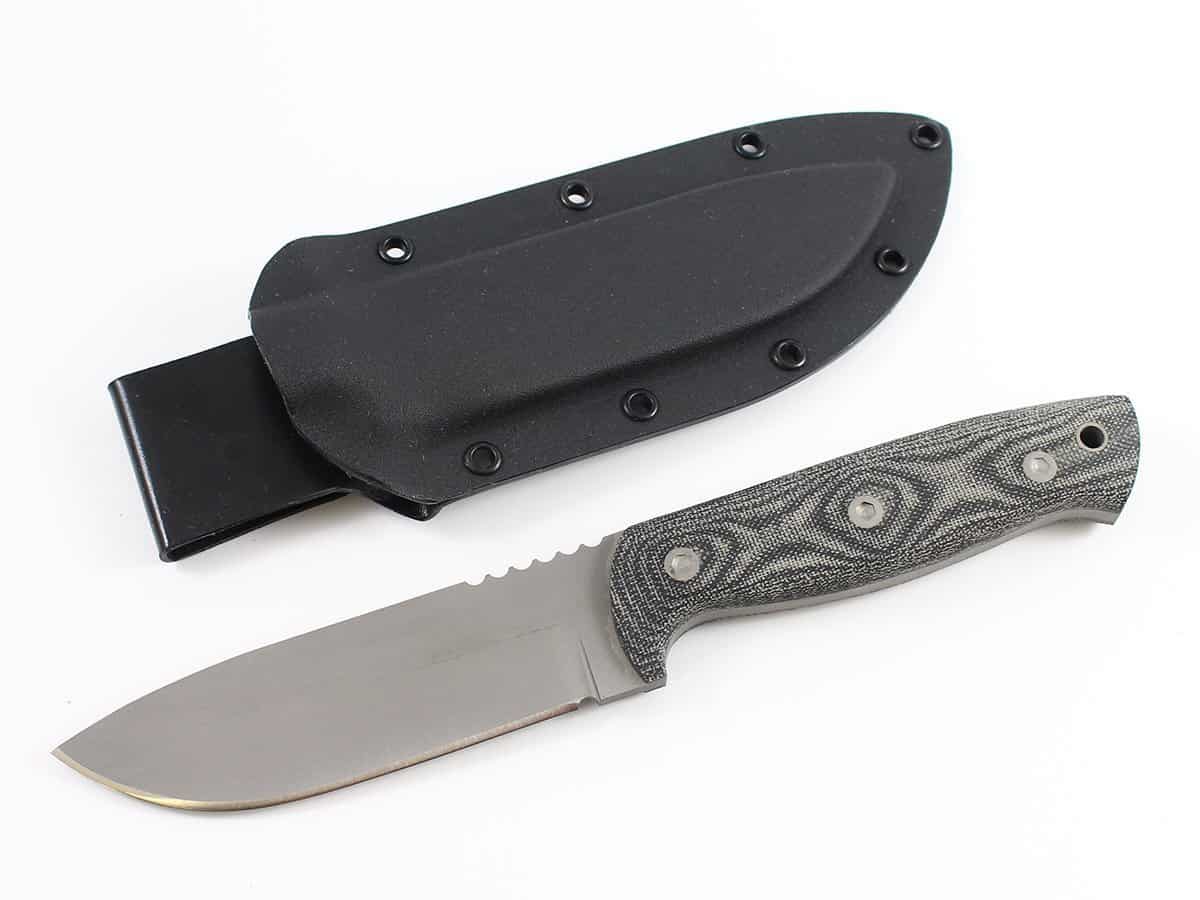 The Entrek Javalina (pronounced Havalina) is a good skinning knife with heavy-duty construction that features an overall length of 8 15/16” with a Drop Point blade design that measures 4 5/16” made from 440C stainless steel hardened to 57-58 HRC with a semi-hollow Saber Grind and a high Primary Bevel Line. In addition, it features Full Tang construction with handle scales made from black canvas Micarta secured to the tang using three, stainless steel, Allen Head screws.
The Entrek Javalina (pronounced Havalina) is a good skinning knife with heavy-duty construction that features an overall length of 8 15/16” with a Drop Point blade design that measures 4 5/16” made from 440C stainless steel hardened to 57-58 HRC with a semi-hollow Saber Grind and a high Primary Bevel Line. In addition, it features Full Tang construction with handle scales made from black canvas Micarta secured to the tang using three, stainless steel, Allen Head screws.
Also, although this knife is technically considered to be a production knife, all Entrek knives are handmade and thus, they feature the same quality construction and attention to detail that good custom knives do. In addition, the deep belly creates an exceptionally long cutting edge for a Drop Point blade design that makes it an excellent choice for skinning animals such as Wild Boar and Feral Hogs (thus the name Javalina).
However, the black canvas Micarta and bead-blasted matte finish do tend to detract somewhat from its visual appeal since most hunters are accustomed to seeing skinning knives with more exotic handle materials and either satin or mirror finishes. However, considering the fact that it is handmade, it is a good value for the money.
8. Kershaw model 1085 Diskin Hunter

The Kershaw Disking Hunter is a relatively inexpensive skinning knife features an overall length of 9 1/2″ inches with a Clip Point blade design measuring 4” in length and is constructed using stonewashed Sandvik 14C28N stainless steel (a very high-quality Swedish blade steel) with an unknown Rockwell Hardness and a Hollow Grind.
Also, this knife features Full Tang construction with an ergonomic grip shape and handle scales made from G10 (a glass reinforced plastic material that is very tough). In addition, the 14C28N stainless steel is a new grade of Swedish blade steel that matches the previous highest achievable hardness without affecting the microstructure and thus, re-sharpening the cutting edge is relatively easy and yet, it also holds an edge very well.
However, some hunters may not appreciate the stonewashed finish and the handle may be too slim for hunters with larger hands. But, considering the relatively inexpensive MSRP, it is still a good value for the money.
9. Buck Model 113 Ranger Skinner
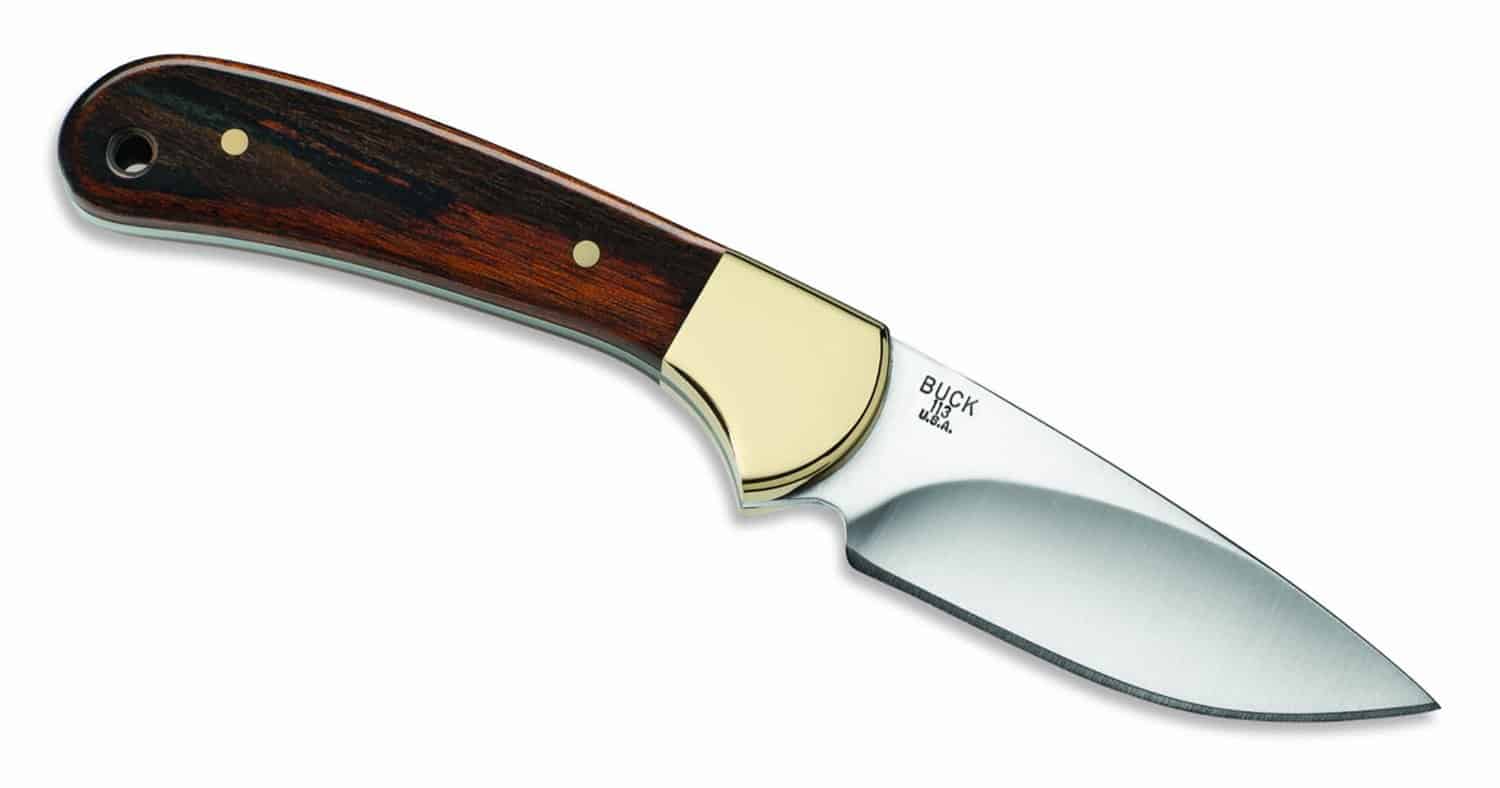 The Buck Ranger Skinner is one of the more elegant skinning knives available and it features an overall length of 7 1/4″ with a Drop Point blade design that measures 3 1/8″ in length. Also, this knife is constructed from 420HC (high carbon) stainless steel hardened to 58 HRC and the blade has a Hollow Grind with a very graceful, arched, Plunge Line.
The Buck Ranger Skinner is one of the more elegant skinning knives available and it features an overall length of 7 1/4″ with a Drop Point blade design that measures 3 1/8″ in length. Also, this knife is constructed from 420HC (high carbon) stainless steel hardened to 58 HRC and the blade has a Hollow Grind with a very graceful, arched, Plunge Line.
In addition, it also features Full Tang construction with high-quality brass bolsters and a very ergonomic handle design with American Walnut handle scales pinned to the tang with two non-mosaic, brass, pins and a lanyard loop. Also, because all Buck knives are heat treated by Paul Bos (commonly considered to be a heat treating guru), their use of 420 High Carbon steel rivals the performance of 440C while enabling them to charge less than if they were still using 440C.
Therefore, the Buck Ranger Skinner is a good value for the money. However, although this knife is an excellent design for skinning small game species, some hunters may find it too small for their liking.
10. Buck Model 103 Skinner
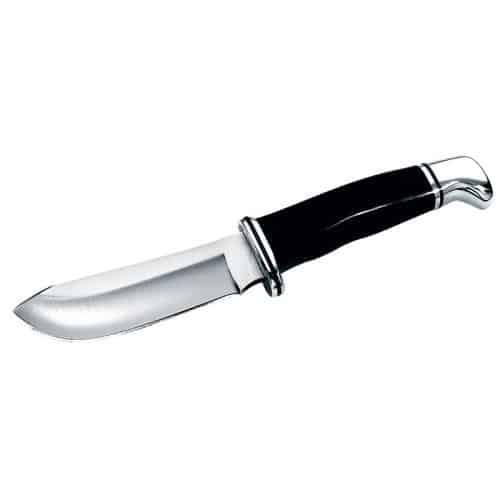 The model 103 Skinner is another one of Buck’s original, vintage, knife designs and it features an overall length of 8 1/4″ with a Nessmuk blade design that measures 4″ in length. Also, this knife is constructed from 420HC (high carbon) stainless steel hardened to 58 HRC with a Hollow Grind.
The model 103 Skinner is another one of Buck’s original, vintage, knife designs and it features an overall length of 8 1/4″ with a Nessmuk blade design that measures 4″ in length. Also, this knife is constructed from 420HC (high carbon) stainless steel hardened to 58 HRC with a Hollow Grind.
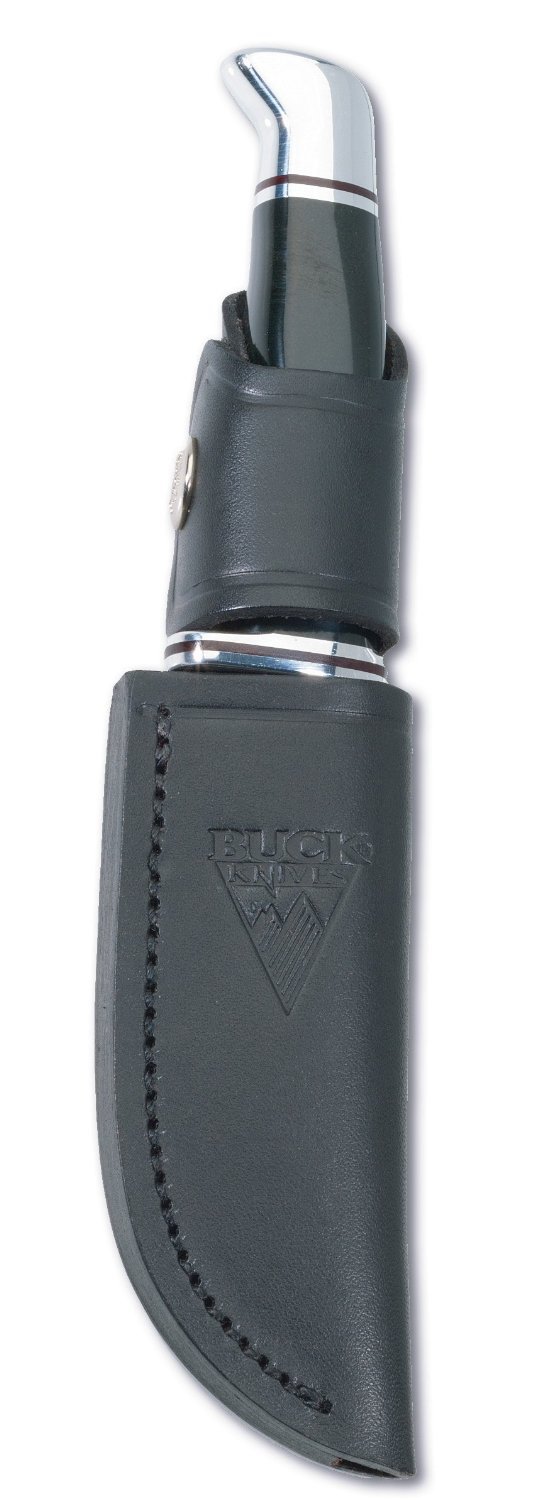 In addition, it also features Stick Tang construction with a vintage Buck handle design made from black, phenolic, plastic with a stainless steel bolster and pommel cap. Also, because all Buck knives are heat treated by Paul Bos (commonly considered to be a heat treating guru), their use of 420 High Carbon steel rivals the performance of 440C while enabling them to charge less than if they were still using 440C. Also, the deep belly and extended cutting edge make this knife an excellent choice for skinning such animals as Wild Boar and Feral Hogs.
In addition, it also features Stick Tang construction with a vintage Buck handle design made from black, phenolic, plastic with a stainless steel bolster and pommel cap. Also, because all Buck knives are heat treated by Paul Bos (commonly considered to be a heat treating guru), their use of 420 High Carbon steel rivals the performance of 440C while enabling them to charge less than if they were still using 440C. Also, the deep belly and extended cutting edge make this knife an excellent choice for skinning such animals as Wild Boar and Feral Hogs.
However, the Nessmuk blade design does not provide the user with particularly good control over the tip of the blade. But, due to its relatively inexpensive MSRP, the Buck model 103 Skinner is a good value for the money.
Let’s sum it up
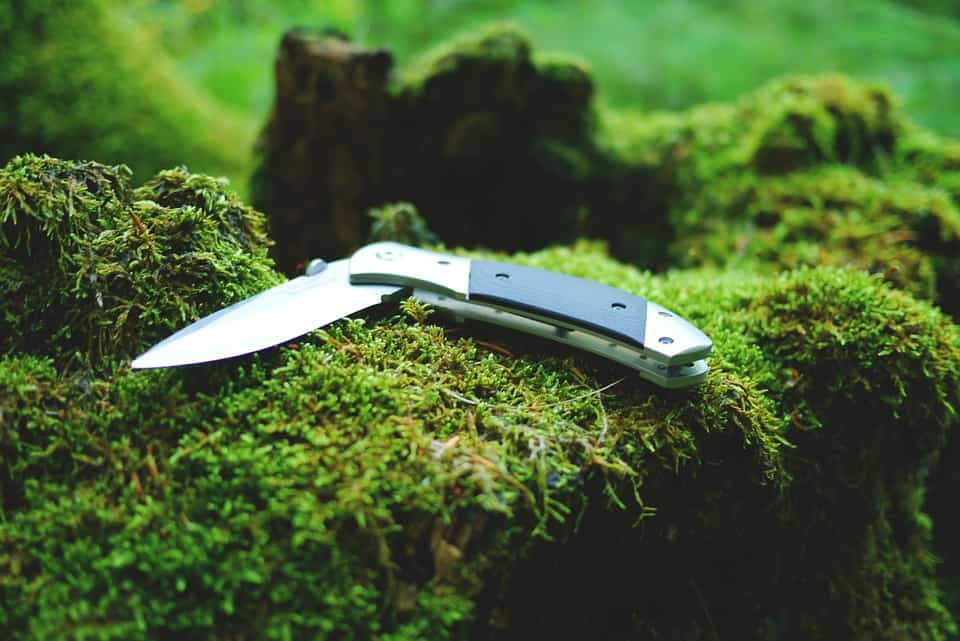 So, although there are many different well designed hunting knives on the market today, the ten knives listed above represent the cream of the crop due to their excellent blade designs and high-quality blade steels.
So, although there are many different well designed hunting knives on the market today, the ten knives listed above represent the cream of the crop due to their excellent blade designs and high-quality blade steels.
However, as you can see from the information listed in our buyer’s guide section above, there is actually quite a bit to consider when purchasing a well-designed hunting knife.
Thus, it is very important that you take the time to consider what game species you are going to use the knife on most often and then choose the blade design, the blade length, the blade steel, and the blade grind accordingly because the wrong choice will undoubtedly leave you frustrated with the poor performance of your knife whereas, the right choice is joy to own and use!









